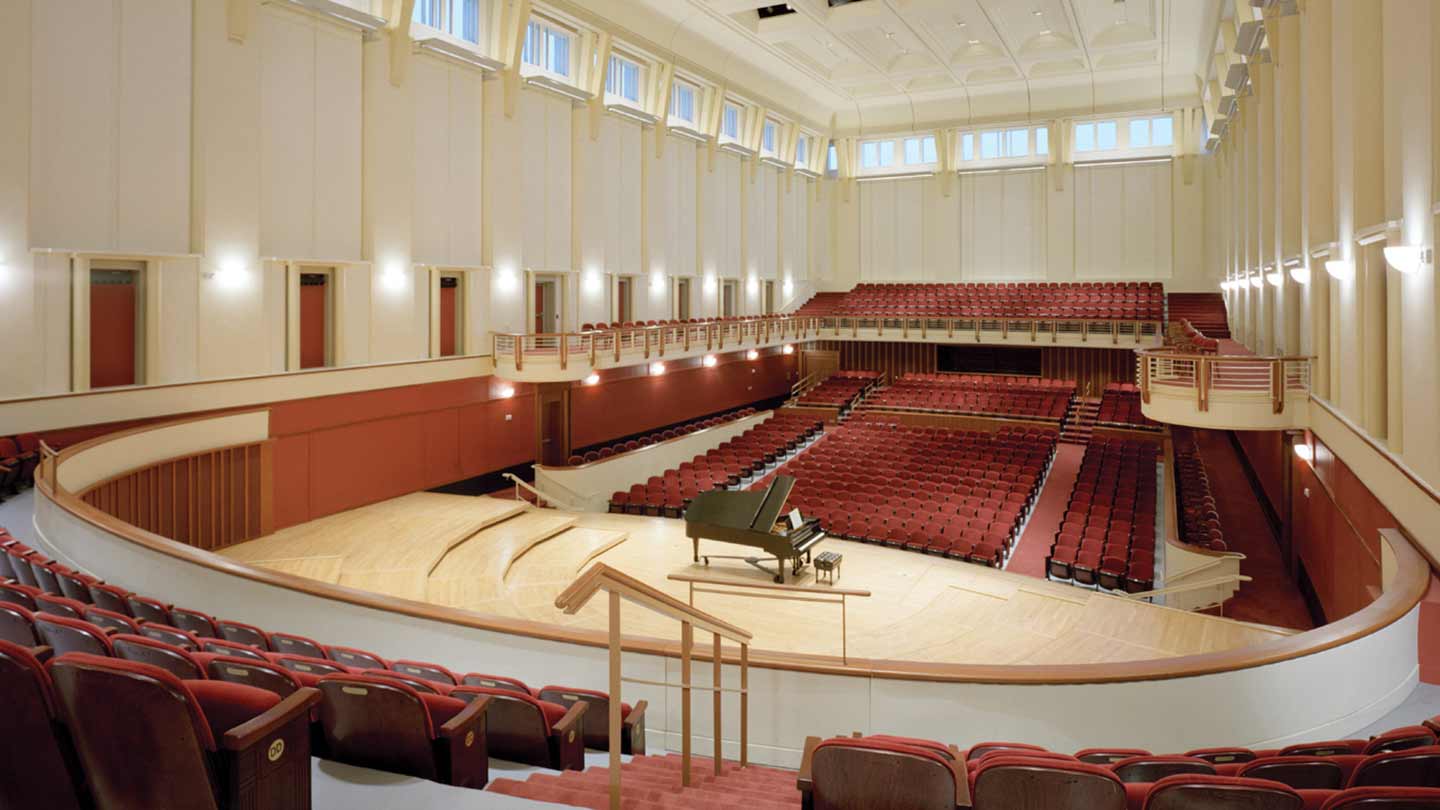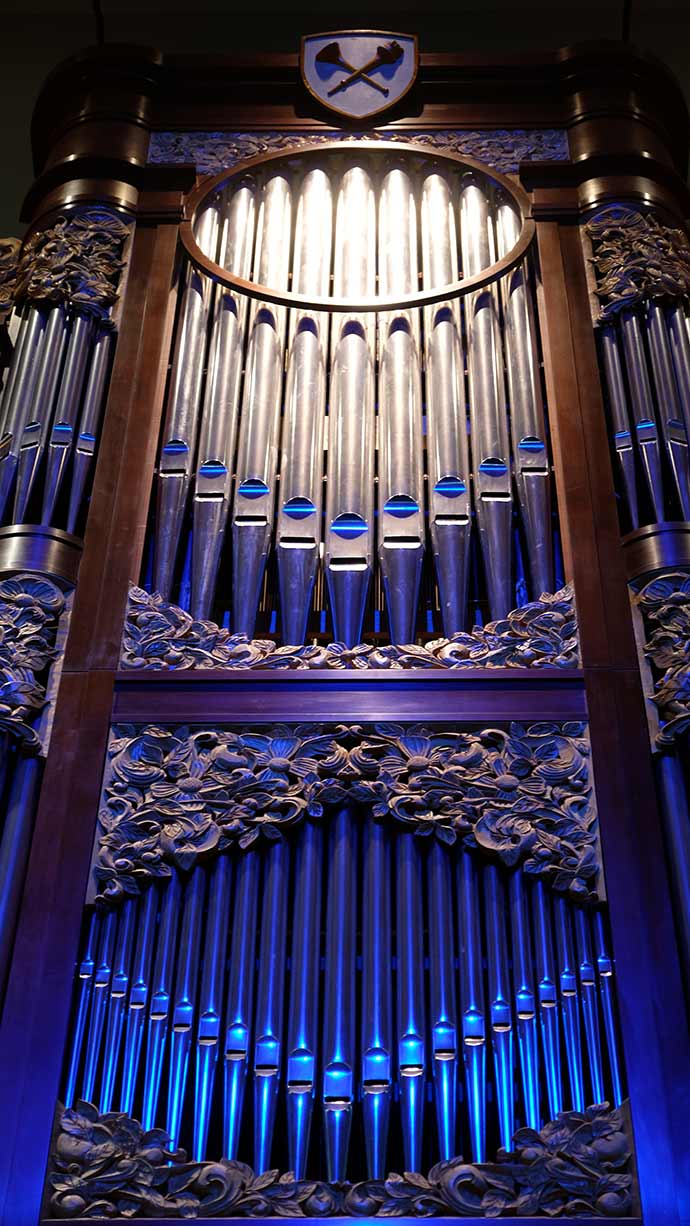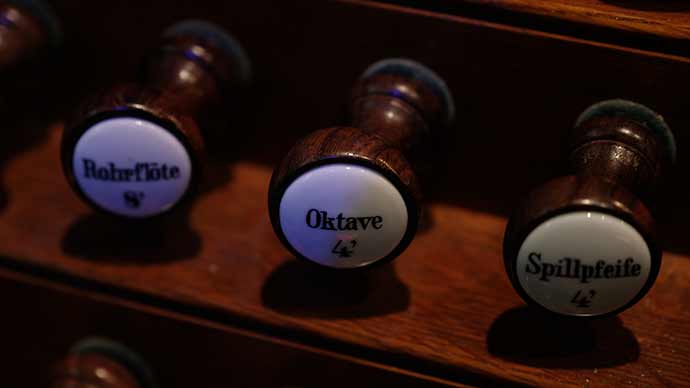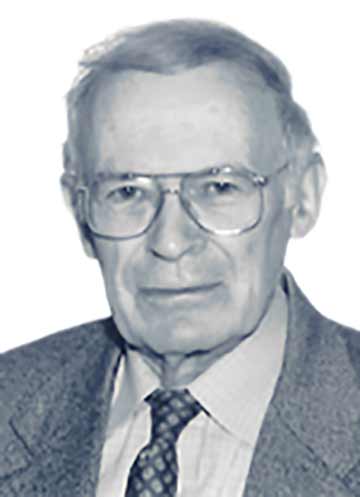
Interior of Emerson Concert Hall. Photo by Paul Warchol.
Cherry Logan Emerson Concert Hall
The Cherry Logan Emerson Concert Hall is an 800-seat hall with choral balcony and orchestra pit. It houses the spectacular Werner Wortsman Memorial Organ.
The architecture of the room is a shoebox design based on the Musikverein Concert Hall in Vienna, the Amsterdam Concertgebouw Concert Hall, and Boston Symphony Hall.
Providing for the best possible acoustics, the hall has multifaceted walls that create no parallel surfaces, and banners that can be adjusted to make the space acoustically correct for any kind of music ensemble or concert.
Emerson Concert Hall was funded by and named after Atlanta scientist Cherry Logan Emerson, who earned both a BA and MA from Emory in the 1930s.
Werner Wortsman Memorial Organ

The Werner Wortsman Memorial Organ. Photo by Mark Teague.
Emerson Concert Hall houses the 14-ton Werner Wortsman Memorial Organ built by top North American builder Daniel Jaeckel and installed in 2005.
Rising 36 feet above the stage, the Werner Wortsman Memorial Organ not only towers as the visual focal point for the Schwartz Center, but it also offers three primary artistic functions:
- to serve for performance of organ solo repertoire
- to complement other Emory University campus organ installations used for performance and graduate studio teaching
- to provide the necessary musical vehicle for the performance of orchestral and choral literature requiring the participation of a concert hall organ
The Werner Wortsman Memorial Organ is named in memory of Werner Wortsman 47C and in recognition of his generous support of the arts at Emory. The organ, a mechanical key-action tracker instrument of 54 stops and 3,605 pipes, is playable from three manuals (keyboards) and pedal board.
The design of the organ case bears tribute to the classical golden section principle in its size ratios. For example, the relationship of the vertical distance from the stage to the bottom of the organ case relative to the height of the entire organ case itself is the same relationship as that of the entire organ case height to the distance from the stage to the top of the organ case.
The case’s cherry wood, rounded pedal towers, and the painted lower panels below the impost all match design elements found in the concert hall. The Emory University coat of arms occupies the top middle position of the organ's highest central tower, surrounded by intricate basswood carvings outlining patterns of Southern foliage.
From Timothy Albrecht, Professor Emeritus of Music
The Werner Wortsman Memorial Organ is one of the first pipe organs built in the United States that uses as a starting point the tonal outlook of 18th-century Alsatian organ builder Andreas Silbermann.
After moving from his native German Saxony to Strasbourg, France, the cosmopolitan capital of Alsace, Silbermann built significant organs that integrated attributes of both the French Classic organ and the German Baroque examples. Similarly, our Werner Wortsman Memorial Organ benefits from the internationalism of its maker who worked extensively with organ builders in both Europe and the United States before setting up his own pipe organ shop in Duluth, Minnesota, in 1978.

Werner Wortsman Memorial Organ detail. Photo by Mark Teague.
Influenced by the classic instruments of Silbermann, our Werner Wortsman Memorial Organ includes a judicious mix of organ-building traditions from different countries. For example, its rounded pedal towers, its facade pipes with their high tin content, and the five-rank mounted cornet all bear a decidedly French Classic imprint. Southern German and Austrian Baroque organ design influences are heard in its generously scaled flute stops.
The organ’s two main keyboard divisions, the Hauptwerk and the Oberwerk, feature more Central German Baroque principal choruses and mixtures, necessary for Bach polyphony. The Romantic harmonic reeds and harmonic flutes of the Recit provide timbres reminiscent of the French-Symphonic organ builder Aristade Cavaillé-Coll.
About the Donor

Werner Wortsman
Werner Wortsman 47C (1925–2009) was raised in Germany with a love for classical music and opera, and at age 13 came to the United States to escape Nazi rule. He served in US Army intelligence in World War II before majoring in journalism at Emory. Living most of his adult life near campus, Wortsman owned a radio station, wrote two books, and participated in Emory alumni events. The value he placed on education, music, and the arts inspired his bequest to the Schwartz Center for Performing Arts at Emory. The Werner Wortsman Memorial Organ was named for him in 2011, in recognition of his generous estate gift to the arts at Emory.